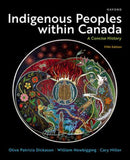Description
The late Olive Patricia Dickason was Professor Emeritus at the University of Alberta and adjunct professor of history at the University of Ottawa. She was the author of several books, named a Member of the Order of Canada in 1996, and received the Aboriginal Life Achievement Award, Canadian Native Arts Foundation, in 1997. Olive Patricia Dickason CM was a Métis historian and journalist. She was the first scholar in Canada to receive a PHD in Indigenous history.
William Newbigging is an Adjunct Professor at Laurentian University, where he has taught Indigenous history since 1993. He holds a doctorate in history from the University of Toronto. He is also a long-time research associate of Batchewana First Nation, Mississauga First Nation, Walpole Island First Nation, as well as many other First Nations and associations across Canada and the United States.
Cary Miller is an Associate Professor and Associate Vice President Indigenous: Curriculum, Scholarship, and Research at the University of Manitoba. Her first book, Ogimaag: Anishinaabeg Leadership, 1760-1845 was published by the University of Nebraska Press in 2010. She is Anishinaabe and descends from St. Croix and Leech Lake communities.
Indigenous Peoples within Canada is a seminal text in the field of Indigenous history in Canada. It spans the full history of Indigenous Peoples, beginning with origin stories and the pre-contact era and then tracing the development of Indigenous-European relations from contact to the present day. The final chapters include updated content on contemporary events such as Wet'suwet'en activism at Wa Dzun Kwuh and Pope Francis' recent apology for residential school abuses. Indigenous perspectives are centred throughout, with Indigenous interpretations of historical events and Indigenous contributions to the history of what is now Canada foregrounded. Indigenous voices are further amplified through the use of autonyms, profiles of Indigenous leaders, art by Indigenous artists, and an expanded transborder perspective that reflects Indigenous views of the land that is now North America. The clear, accessible writing style and many pedagogical features, including an autonym chart and timelines and maps in every chapter, aid student comprehension throughout the text.
Updates to the fourth edition:
- Concise yet comprehensive coverage of the history of Indigenous Peoples within Canada introduces students to the vitality of Indigenous societies before contact, examines the effects of European colonialism, and explores current processes of reconciliation, revitalization, and resurgence.
- Indigenous voices and perspectives are centred throughout, and updated terminology and autonyms are used for Indigenous Peoples, nations, and confederacies, honouring the rights of Indigenous Peoples to self-representation and self-determination.
- Updated coverage of current events, including the Wet'suwet'en resistance to the Coastal GasLink Pipeline, the Final Report of the National Inquiry into Missing and Murdered Indigenous Women and Girls, and the discovery of mass graves at Kamloops and other residential school sites; links historical patterns to issues of pressing importance today.
- New content emphasizes the voices of Indigenous women, bringing a greater focus throughout to women's issues and history.
- An expanded transborder perspective presents the history of North America as Indigenous Peoples have always seen it, as one inter-connected whole.
- An accessible writing style and robust pedagogical features, including an autonym chart, timelines, maps, and "Historical Background" and "Indigenous Leaders" feature boxes, help students to understand and contextualize historical material.
This book contains 75 photos; 53 maps; 5 tables, 7.5" x 9.25".


